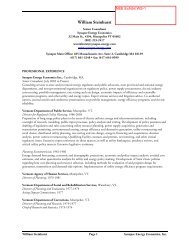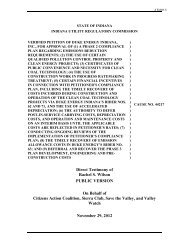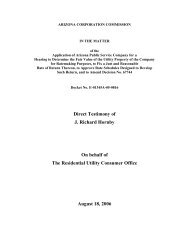Best Practices in Energy Efficiency Program Screening - Synapse ...
Best Practices in Energy Efficiency Program Screening - Synapse ...
Best Practices in Energy Efficiency Program Screening - Synapse ...
Create successful ePaper yourself
Turn your PDF publications into a flip-book with our unique Google optimized e-Paper software.
spillover from program activity <strong>in</strong> previous years may be identified as free<br />
ridership <strong>in</strong> the current program year. (NMR 2010, page 34)<br />
Requires large expenditures of resources that are not <strong>in</strong> keep<strong>in</strong>g with the<br />
importance of the estimates and their reliability and validity, thereby divert<strong>in</strong>g<br />
resources from other plann<strong>in</strong>g, evaluation, and implementation activities that<br />
could yield greater benefits. (NMR 2010, page 18)<br />
Some parties argue that “the focus on m<strong>in</strong>imiz<strong>in</strong>g free ridership is<br />
counterproductive and greater sav<strong>in</strong>gs could be achieved if the focus were on<br />
maximiz<strong>in</strong>g outreach and not on avoid<strong>in</strong>g outreach to the “wrong people” (i.e.,<br />
free riders)” (NMR 2010, page 44).<br />
However, NMR (2010) also found that many stakeholders still emphasize the importance<br />
of the use of net sav<strong>in</strong>gs because net sav<strong>in</strong>gs allow us to assess the effectiveness of<br />
various program designs and whether the designs should be replicated, expanded,<br />
revised, or discont<strong>in</strong>ued. It also allows us to ensure that ratepayer or taxpayer funds are<br />
be<strong>in</strong>g spent responsibly and <strong>in</strong> a manner that ensures that efficiency is the lowest-cost<br />
resource (NMR 2010, 18).<br />
F<strong>in</strong>ally, market transformation programs present a dist<strong>in</strong>ct challenge with regard to costeffectiveness<br />
screen<strong>in</strong>g. These programs are explicitly designed to achieve sav<strong>in</strong>gs<br />
beyond the direct program impacts (i.e., spillover effects); sav<strong>in</strong>gs that might not occur<br />
for several years, might last for many years beyond that, and might be very difficult to<br />
quantify. Screen<strong>in</strong>g these programs without account<strong>in</strong>g for their spillover effects would<br />
clearly understate their true value and would preclude many valuable programs from<br />
proceed<strong>in</strong>g. The options for address<strong>in</strong>g this issue <strong>in</strong>clude: (a) allow<strong>in</strong>g these programs to<br />
be implemented even if they do not have a benefit cost ratio of one or greater;<br />
(b) <strong>in</strong>clud<strong>in</strong>g the costs and benefits of these programs with<strong>in</strong> the evaluation of other<br />
related programs, and requir<strong>in</strong>g that the comb<strong>in</strong>ed program be cost-effective; or<br />
(c) develop<strong>in</strong>g an adder to the estimated benefits to best represent the likely spillover<br />
effects of the market transformation program.<br />
Recommendations<br />
We recommend that program adm<strong>in</strong>istrators and other stakeholder place less emphasis<br />
on free-ridership and greater emphasis on spillover and market transformation effects, <strong>in</strong><br />
order to achieve more balance between these effects. In addition, all of these effects<br />
should be accounted for <strong>in</strong> a more timely and effective manner as part of program<br />
process evaluation, <strong>in</strong> order to <strong>in</strong>form whether a program should be redesigned or<br />
replaced as a result of these effects. 26<br />
We recommend that free-riders be treated consistently <strong>in</strong> estimat<strong>in</strong>g both the costs and<br />
benefits of energy efficiency programs. If the impacts of free-riders are subtracted from<br />
the efficiency sav<strong>in</strong>gs, then the impacts of free-riders should be subtracted from the cost<br />
estimates as well.<br />
26 In Massachusetts, the state regulator, utilities, and other stakeholders are currently <strong>in</strong>vestigat<strong>in</strong>g this<br />
issue, and try<strong>in</strong>g to develop ways to estimate net sav<strong>in</strong>gs that achieve three core benefits (1) <strong>in</strong>creased<br />
reliability and accuracy <strong>in</strong> report<strong>in</strong>g program-delivered sav<strong>in</strong>gs (which also capture multi-year impacts<br />
from program efforts <strong>in</strong> the multi-year plann<strong>in</strong>g cycle); (2) better plann<strong>in</strong>g assumptions for program<br />
strategies; and (3) <strong>in</strong>creased adm<strong>in</strong>istrative efficiency (MA Jo<strong>in</strong>t Comments 2012)<br />
| 44 <strong>Best</strong> <strong>Practices</strong> <strong>in</strong> <strong>Energy</strong> <strong>Efficiency</strong> <strong>Program</strong> Screen<strong>in</strong>g | www.nhpci.org







